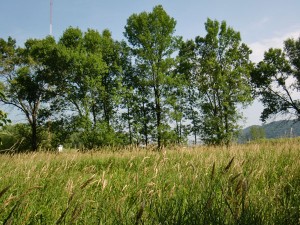Posted 1:40 p.m. Friday, Aug. 14, 2015

Graduate student continues research on reed canary grass and how to restore the floodplain forests.
 A very well established reed canary grass community of seedling in a local floodplain. Photo provided by Whitney Swanson.[/caption]
“If you see a grass field while canoeing on the rivers in the area, it’s probably reed canary grass,” says Swanson.
The grass comes into established forests and absorbs nutrients the trees need, slowing any natural restoration efforts. On top of that, reed canary grass is changing the soil structure. “It doesn’t help capture nitrogen,” says Swanson. “It’s potentially letting it flow farther downstream and change other ecosystems.”
The U.S. Geological Survey says an excess of nitrogen could lead to the extinction of aquatic animals and plants, and could potentially be dangerous for young infants or young livestock.
In 2012, the U.S Fish and Wildlife Service said reed canary grass had invaded nearly 40,000 acres of refuge land in the Midwest alone.
“It’s a big deal,” says Swanson. “You don’t want to lose these hundreds of acres of floodplains to one grass.”
https://www.youtube.com/watch?v=j6vggPFDo-k
Reed canary grass is one of several topics that will be discussed at an upcoming conference on rivers in La Crosse. Find more details about the gathering: http://www.uwlax.edu/conted/isrs2015/
A very well established reed canary grass community of seedling in a local floodplain. Photo provided by Whitney Swanson.[/caption]
“If you see a grass field while canoeing on the rivers in the area, it’s probably reed canary grass,” says Swanson.
The grass comes into established forests and absorbs nutrients the trees need, slowing any natural restoration efforts. On top of that, reed canary grass is changing the soil structure. “It doesn’t help capture nitrogen,” says Swanson. “It’s potentially letting it flow farther downstream and change other ecosystems.”
The U.S. Geological Survey says an excess of nitrogen could lead to the extinction of aquatic animals and plants, and could potentially be dangerous for young infants or young livestock.
In 2012, the U.S Fish and Wildlife Service said reed canary grass had invaded nearly 40,000 acres of refuge land in the Midwest alone.
“It’s a big deal,” says Swanson. “You don’t want to lose these hundreds of acres of floodplains to one grass.”
https://www.youtube.com/watch?v=j6vggPFDo-k
Reed canary grass is one of several topics that will be discussed at an upcoming conference on rivers in La Crosse. Find more details about the gathering: http://www.uwlax.edu/conted/isrs2015/